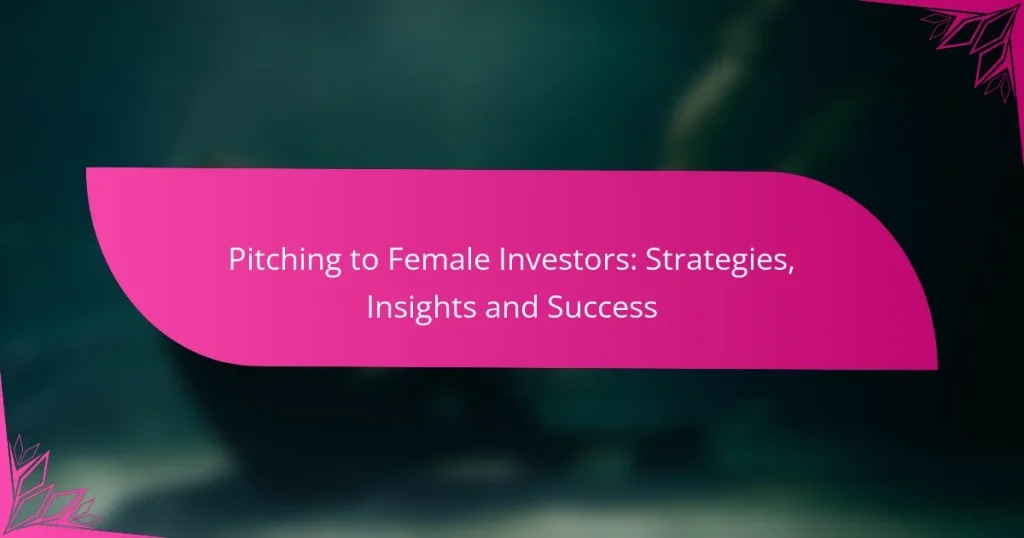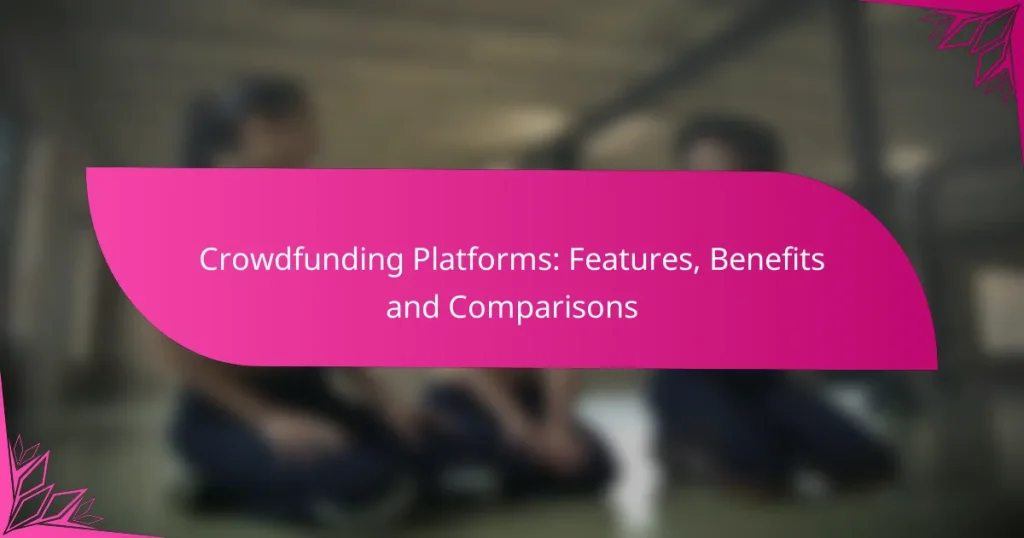Women innovators play a crucial role in driving economic growth and technological advancement, yet they often face significant challenges in securing funding. Various options, such as venture capital, government grants, and crowdfunding, are available to support their entrepreneurial endeavors. By developing strong business strategies and leveraging supportive networks, female entrepreneurs can enhance their chances of attracting investment and overcoming systemic barriers in the funding landscape.
Women-Led Startups: Case Studies, Success Stories and Funding
Pitching to Female Investors: Strategies, Insights and Success
Crowdfunding Platforms: Features, Benefits and Comparisons
Success Metrics: ROI, Impact and Funding Evaluation
Grants and Funding: Opportunities, Resources and Support
Investment Challenges: Solutions, Strategies and Insights
What funding options are available for women innovators in the US?
Women innovators in the US have access to various funding options including venture capital, government grants, angel investors, and crowdfunding platforms. Each option has unique characteristics and requirements that can help female entrepreneurs secure the necessary capital to grow their businesses.
Venture capital firms focused on women-led startups
Venture capital firms that focus on women-led startups provide essential funding and mentorship to female entrepreneurs. These firms often seek to invest in companies that demonstrate strong growth potential and innovative solutions. Notable firms include Female Founders Fund and BBG Ventures, which specifically target women-led businesses.
When approaching venture capital firms, it’s crucial to have a solid business plan and a clear value proposition. Prepare to articulate how your startup addresses a specific market need and the potential return on investment for the firm.
Government grants for female entrepreneurs
Government grants are a valuable funding source for women entrepreneurs, offering non-repayable funds to support business development. Programs like the Small Business Administration’s (SBA) Office of Women’s Business Ownership provide resources and grant opportunities specifically for women. These grants can cover various business expenses, from startup costs to research and development.
To apply for government grants, familiarize yourself with eligibility requirements and application processes. It’s beneficial to have a detailed proposal that outlines your business goals, budget, and how the grant will be utilized to achieve success.
Angel investors supporting women innovators
Angel investors are individuals who provide capital to startups in exchange for equity or convertible debt. Many angel investors are particularly interested in supporting women innovators, recognizing the unique perspectives and solutions they bring to the market. Organizations like Astia and Golden Seeds specifically connect women entrepreneurs with angel investors.
Building relationships with potential angel investors can be key to securing funding. Attend networking events, pitch competitions, and industry conferences to meet investors who are passionate about supporting women-led ventures.
Crowdfunding platforms tailored for women
Crowdfunding platforms offer women innovators an opportunity to raise funds from a large number of people, typically via the internet. Platforms like Kickstarter and Indiegogo allow entrepreneurs to present their ideas and attract backers who believe in their vision. Some platforms, such as SheEO, focus exclusively on women-led projects.
When using crowdfunding, create a compelling campaign that clearly communicates your mission and goals. Engaging visuals and a strong marketing strategy can significantly increase your chances of reaching your funding target. Consider offering attractive rewards to backers to incentivize contributions.
How can women innovators secure investment?
Women innovators can secure investment by developing a compelling business strategy, connecting with supportive investor networks, and seeking mentorship. These steps help build credibility and create opportunities for funding.
Building a strong business plan
A robust business plan is essential for attracting investors. It should clearly outline your business model, target market, competitive advantage, and financial projections. Aim for a plan that is concise yet detailed enough to convey your vision and potential for growth.
Include a clear executive summary, market analysis, and a marketing strategy. Investors typically look for plans that demonstrate a clear understanding of the market and a viable path to profitability.
Networking with female-focused investor groups
Connecting with female-focused investor groups can significantly enhance funding opportunities. These networks often prioritize investing in women-led businesses and can provide valuable insights and resources.
Consider joining organizations like Golden Seeds or the Female Founders Fund, which specifically support women entrepreneurs. Attend events and workshops to build relationships and gain visibility within these communities.
Leveraging mentorship programs
Mentorship programs can provide guidance and support that is crucial for securing investment. A mentor can help refine your pitch, connect you with potential investors, and offer advice based on their own experiences.
Look for programs that focus on women in business, such as SCORE or the Women’s Business Enterprise National Council (WBENC). Engaging with a mentor can not only enhance your business acumen but also expand your professional network.
What are the challenges faced by women innovators in funding?
Women innovators often encounter significant challenges in securing funding, primarily due to systemic biases and barriers within the investment landscape. These obstacles can hinder their ability to access necessary resources for growth and development.
Gender bias in investment decisions
Gender bias in investment decisions manifests when investors unconsciously favor male entrepreneurs over female counterparts. Studies indicate that pitches led by women receive less funding compared to those led by men, often due to stereotypes about leadership and capability.
This bias can lead to women innovators being undervalued, despite having equally viable business ideas. To counteract this, women should seek out investors who prioritize diversity and actively challenge traditional biases in their funding practices.
Lack of access to networks
Women innovators frequently face a lack of access to critical networks that can facilitate funding opportunities. Networking events and investor circles often skew male-dominated, making it harder for women to connect with potential backers.
Building a strong network is essential; women can benefit from joining industry-specific groups, mentorship programs, and online platforms that focus on female entrepreneurs. Actively participating in these communities can enhance visibility and open doors to funding sources.
Limited visibility in traditional funding channels
Limited visibility in traditional funding channels often means that women-led businesses are overlooked by mainstream investors. Many funding platforms and venture capital firms have historically favored male-led startups, resulting in fewer opportunities for women innovators.
To improve visibility, women should consider alternative funding sources such as crowdfunding, angel investors focused on diversity, and grants specifically aimed at women entrepreneurs. Leveraging social media and personal branding can also help raise awareness and attract potential investors.
What criteria do investors look for in women-led startups?
Investors typically seek several key criteria when evaluating women-led startups, including market potential, a strong leadership team, and an innovative product or service. These factors help determine the likelihood of success and scalability in a competitive landscape.
Market potential and scalability
Market potential refers to the size and growth prospects of the target market for a startup’s product or service. Investors look for startups that can capture a significant share of a growing market, ideally with a clear path to scalability. A startup should demonstrate how it plans to expand its customer base and increase revenue over time.
To assess market potential, startups can conduct thorough market research, analyze industry trends, and identify target demographics. Presenting data on market size, growth rates, and competitive landscape can strengthen a pitch to investors.
Strong leadership team
A strong leadership team is crucial for the success of any startup, and investors pay close attention to the backgrounds and experiences of the founders. A diverse team with complementary skills and a proven track record can instill confidence in investors regarding the startup’s ability to execute its vision.
Startups should highlight the unique qualifications of their leadership team, including relevant industry experience, previous entrepreneurial successes, and any notable achievements. Building a strong advisory board can also enhance credibility and attract investment.
Innovative product or service offering
Investors are drawn to startups that offer innovative products or services that solve real problems or meet unmet needs in the market. A compelling value proposition that clearly differentiates the offering from competitors is essential for capturing investor interest.
Startups should articulate the unique features and benefits of their product or service, backed by customer feedback or pilot results. Demonstrating a clear understanding of the competitive landscape and how the offering stands out can significantly enhance the appeal to potential investors.
How can women innovators improve their funding prospects?
Women innovators can enhance their funding prospects by actively seeking opportunities that showcase their ideas and connect them with potential investors. By participating in pitch competitions, utilizing online platforms, and engaging with community support organizations, they can increase visibility and access to funding sources.
Participating in pitch competitions
Pitch competitions provide a platform for women innovators to present their ideas to a panel of judges and potential investors. These events often offer cash prizes, mentorship, and networking opportunities, making them valuable for securing funding. Women should look for local and national competitions that focus on their industry or target demographic.
To maximize success, participants should prepare a clear and compelling pitch that highlights their unique value proposition. Practicing in front of peers can help refine delivery and address potential questions from judges. Researching previous winners can also provide insights into what resonates with investors.
Utilizing online platforms for visibility
Online platforms like crowdfunding sites and social media can significantly boost visibility for women innovators. Websites such as Kickstarter or Indiegogo allow innovators to showcase their projects and attract funding from a global audience. Additionally, social media channels can be used to build a community and engage with potential supporters.
Women should create a strong online presence by sharing their journey, project updates, and success stories. Engaging with followers through regular updates and responding to inquiries can foster a loyal supporter base. Using targeted hashtags can also increase reach and connect with like-minded individuals and investors.
Engaging with community support organizations
Community support organizations often provide resources, mentorship, and networking opportunities specifically tailored for women entrepreneurs. These organizations can help innovators navigate the funding landscape and connect them with investors who are interested in supporting female-led ventures. Examples include local business incubators and women-focused entrepreneurship groups.
To leverage these resources, women should actively participate in workshops, networking events, and mentorship programs offered by these organizations. Building relationships with other entrepreneurs can lead to collaborative opportunities and shared funding resources. Staying informed about grants and funding initiatives specifically aimed at women can also enhance funding prospects.






